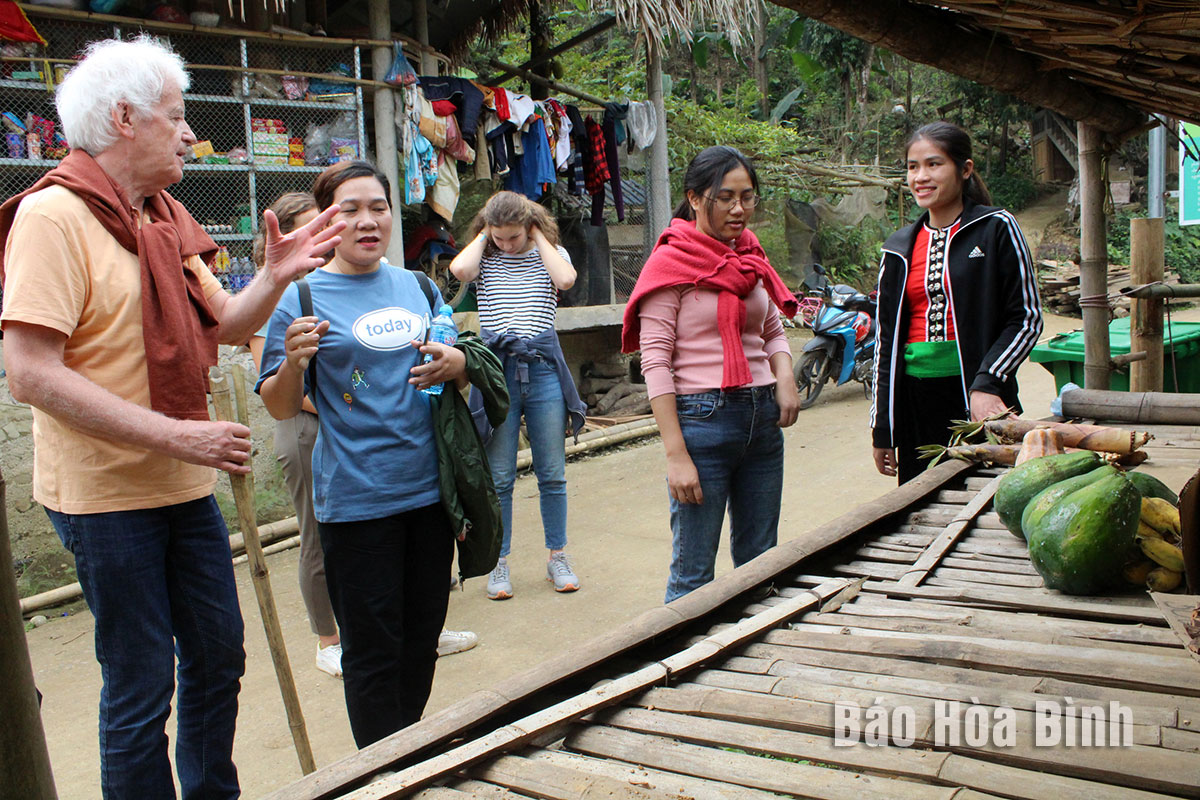
Da Bia hamlet, now Duc Phong, in Tien Phong commune, Da Bac district, was once almost isolated from the outside as the only way to the hamlet was to get a boat ride across the Hoa Binh reservoir. However, as its tourism potential has been unleashed, the hamlet has established itself as one of the most attractive destinations on the tourism map. It has even received the ASEAN Community-Based Tourism Awards in 2019.

Bui
Thi Nhem (R), who is running a homestay in Duc Phong, briefing tourists on the
self-service shop model.
Ban Thi Kim Quy, Vice Chairwoman of the district
People's Committee, stressed that the beautiful natural landscapes, rich
culture, and changing mindset have helped turn tourism into a key economic
sector, generating numerous jobs and improving living standards, particularly for
ethnic minority communities.
This transformation is evident not only in Duc Phong
but also in other hamlets engaging in community tourism throughout the
district, she said, taking the example of Sung hamlet in Cao Son commune, which
has emerged to a bright spot in community tourism from a poor, isolated
locality.
According to Ly Sao Mai, from Da Bac Community-Based
Tourism JSC in Sung hamlet, among the 75 Dao households there, only a few are
currently running homestays, while the others have actively contributed to
local tourism development by offering products and tour guide services.
Quy said over the past years, apart from
implementing action programmes and plans on community tourism, the district has
paid attention tourism promotion, market connectivity, and brand building.
The district expects to welcome 550,000 visitors by
2025, of them 25,000 international, and earn over 297 billion VND (11.91
million USD) from the tourism sector.
A diverse chain of eco-tourism and resort destinations concentrated in Hoa Binh city and the districts of Tan Lac, Da Bac, and Luong Son… Along with the launch of several key high-quality resort tourism projects, these developments have reshaped the landscape and enhanced the appeal of Hoa Binh as a travel destination.
Boasting diverse terrain, a mild climate, and rich natural resources, Cao Phong district is increasingly asserting its place on Vietnam’s tourism map, attracting both domestic and foreign visitors. The district is renowned for its stunning landscapes, majestic mountains, a crystal-clear hydropower lake, and the unique cultural identity of local ethnic groups.
With its pristine landscapes, unique cultural heritage of Muong ethnic minority, and an expanding range of visitor experiences, Tan Lac district of Hoa Binh has fast become a captivating destination for both domestic and international tourists.
Until now, Sung village in Cao Son commune, Da Bac district remains the only Dao ethnic community in Hoa Binh province to develop a community-based tourism model. Beyond its untouched natural landscapes, cultural identity serves as the cornerstone attraction for visitors.
Alongside the diverse cultural identities of the Kinh, Muong, Tay, Thai, Dao, and Mong ethnic people, Hoa Binh province is also renowned as the "capital" of the northwestern Vietnamese cuisine, offering unique and distinctive dishes. At festivals, during Lunar New Year (Tet), or on significant family or community occasions, special dishes are prepared, leaving a lasting impression on visitors.
A Phong Linh (Yellow Tabebuia) flower garden in Thang village, Thach Yen commune, Cao Phong district is currently in full bloom, drawing a large number of visitors.



